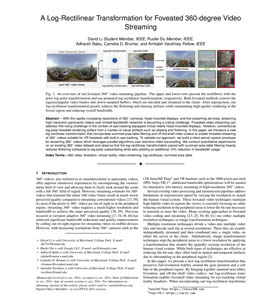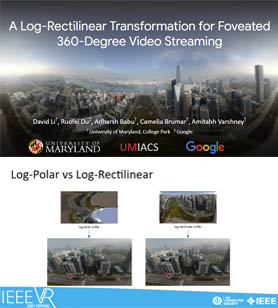Abstract
With the rapidly increasing resolutions of 360° cameras, head-mounted displays, and live-streaming services, streaming high-resolution panoramic videos over limited-bandwidth networks is becoming a critical challenge. Foveated video streaming can address this rising challenge in the context of eye-tracking-equipped virtual reality head-mounted displays. However, conventional log-polar foveated rendering suffers from a number of visual artifacts such as aliasing and flickering. In this paper, we introduce a new log-rectilinear transformation that incorporates summed-area table filtering and off-the-shelf video codecs to enable foveated streaming of 360° videos suitable for VR headsets with built-in eye-tracking. To validate our approach, we build a client-server system prototype for streaming 360° videos which leverages parallel algorithms over real-time video transcoding. We conduct quantitative experiments on an existing 360° video dataset and observe that the log-rectilinear transformation paired with summed-area table filtering heavily reduces flickering compared to log-polar subsampling while also yielding an additional 11% reduction in bandwidth usage.
Downloads
Citation
@article{Li2021LogRectilinear,
author={Li, David and Du, Ruofei and Babu, Adharsh and Brumar, Camelia D. and Varshney, Amitabh},
journal={IEEE Transactions on Visualization and Computer Graphics},
title={A Log-Rectilinear Transformation for Foveated 360-degree Video Streaming},
year={2021},
volume={27},
number={5},
pages={2638-2647},
doi={10.1109/TVCG.2021.3067762}
}
David Li, Ruofei Du, Adharsh Babu, Camelia Brumar, and Amitabh Varshney. 2021. A Log-Rectilinear Transformation for Foveated 360-Degree Video Streaming. IEEE Transactions on Visualization and Computer Graphics, 27(5), 2638-2647. DOI: https://doi.org/10.1109/TVCG.2021.3067762




